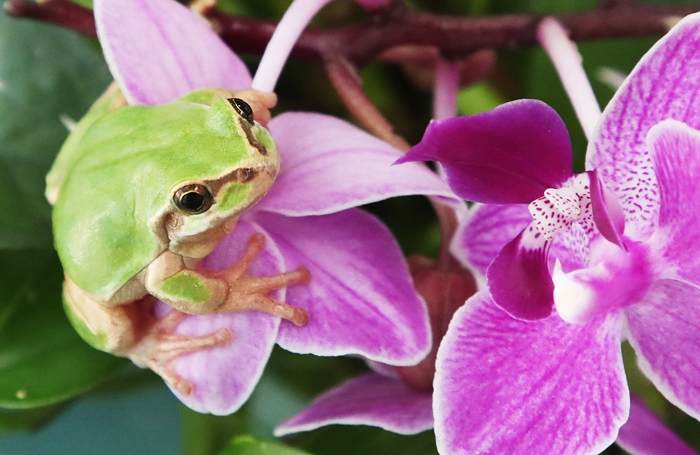
A green frog sits on a moth orchid at the Gyeonggi-do Agricultural Research & Extension Services center in Hwaseong-si, Gyeonggi-do, on March 6, the day of Gyeongchip. (Yonhap News)
By Min Yea-ji and Hahm Hee-eun
Gyeongchip (경칩, 驚蟄), the day when frogs wake from their hibernation and when spring begins to reappear across the Korean Peninsula, has come once again.
The 24 solar terms of the year are about 15 days apart and they're determined by the celestial longitude of the sun. Gyeongchip marks the beginning of the third solar term.
Marking the start of spring, Gyeongchip was an important day for agrarian ancestors. They would plaster walls or build new ones on Gyeongchip, believing that there wouldn’t be any trouble with earthwork on this day. The tradition of burning the rice fields to control pests and to pray for a good harvest would always take place before Gyeongchip.
Although the day is not as well-known as it used to be, traditional agricultural societies thought that the first animals to wake for the spring gave a certain liveliness to the universe. So they used to scoop up and eat frog or salamander eggs, believing that they would make their eyes and minds clearer.
Another Gyeongchip tradition that does continue today is drinking the sap of the mono maple tree. At this time of year, extraction of mono maple sap in the southern and central regions of the country is in full swing. It's believed that drinking this delicious tree sap on Gyeongchip could cure stomach disorders or any internal disease.
According to the 24 solar terms, the onset of the first term on Ipchun (입춘, 立春), followed by Wusu (우수, 雨水), Gyeongchip (경칩, 驚蟄) and Chunbun (춘분, 春分) will together eventually show that spring has arrived in Korea.
jesimin@korea.kr
Most popular
- Council sets minimum hourly wage in 2026 at KRW 10,320
- Songs from 'KPop Demon Hunters' dominate global Billboard charts
- Songs from animated K-pop film rule Spotify daily chart in US
- 28th annual Boryeong Mud Festival to offer more night events
- Exhibition 'K-Comics World' hawks webtoons in 5 countries
